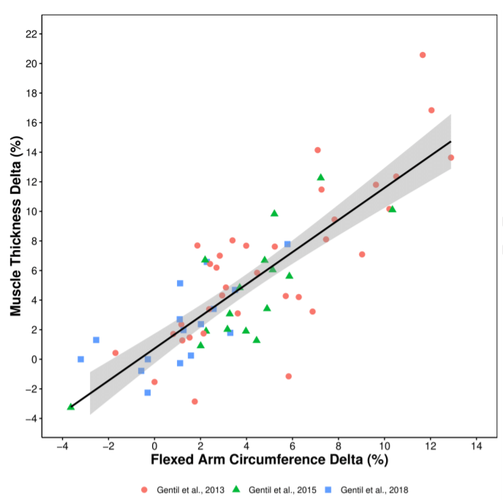-
Home
-
About JCTR
-
Gold Open Access
-
Issues
-
Editorial board
-
Author guidelines
-
Publication fees
-
Online first
-
Special issues
-
News
-
Publication ethics
-
Partners
-
Submit your manuscript
-
Submit your review report
-
Editorial Office
-

This work is licensed under a Creative Commons Attribution-NonCommercial 4.0 International License. ISSN print: 2382-6533 ISSN online: 2424-810X
Volume 6 Issue 2
Evaluating the results of resistance training using ultrasound or flexed arm circumference: A case for keeping it simple?
Paulo Gentil, Emily Budzynski-Seymour, Daniel Souza, James Steele, James P. Fisher, Martim Bottaro
Gentil et al., J Clin Transl Res 2020; 6(2):4
Published online: August 8, 2020
Abstract
Background: The present study aimed to compare changes in muscle size when measured by ultrasound (MT, muscle thickness) and arm circumference (AC) using data from young men.
Methods: The investigation involved data from 3 previous studies involving a total 67 young men who performed resistance training (RT) for 10-12 weeks. Before and after the training period, elbow flexor MT was evaluated by ultrasound and AC was measured. We conducted two-stage individual patient data random effects meta-analyses using both Frequentist and Bayesian hypothesis testing. One-sample analyses examined the absence or presence of change in both MT and AC, and paired analyses examined whether these differed from one another or equivalent.
Results: One-sample analysis supported that both AC (+4.9%; t p = 0.0002; BF10 = 6,255,759,515) and MT (+3.9%; p < 0.0001; BF10 = 7,958,241,773) suggested that change in muscle size had occurred. Frequentist paired comparisons suggested that the estimates of change between both AC and MT measures did not significantly differ (p = 0.1092) but where not statistically equivalent. Bayesian paired comparisons however suggested that MT estimates where greater in magnitude than AC estimates for change in muscle size (BF10 = 16.39174).
Conclusion: Both MT and AC are able to detect RT induced changes in muscle size of the upper arm, but that the magnitude of changes may differ. Thus, care should be taken when comparing or combining estimates using either approach. Relevance for patients: The use of AC might be considered as a practical and low-cost alternative to detect changes in muscle size.

DOI: http://dx.doi.org/10.18053/jctres.06.202002.004
Author Affiliation
1 College of Physical Education and Dance, Federal University of Goias, Goiania, GO, Brazil
2 School of Sport, Health, and Social Sciences, Solent University, Southampton, UK
3 ukactive Research Institute, London, UK
4 College of Physical Education, University of Brasília, Brasília, DF, Brazil
*Corresponding author
Daniel Souza
Avenida Esperança s/n, Campus Samambaia, Goiânia, Goiás, Brasil,
CEP: 74.690-900
Email: daniel_souza86@hotmail.com
Handling editor:
Michal Heger
Department of Pharmaceutics, Utrecht University, the Netherlands
Department of Pharmaceutics, Jiaxing University Medical College, Zhejiang, China

